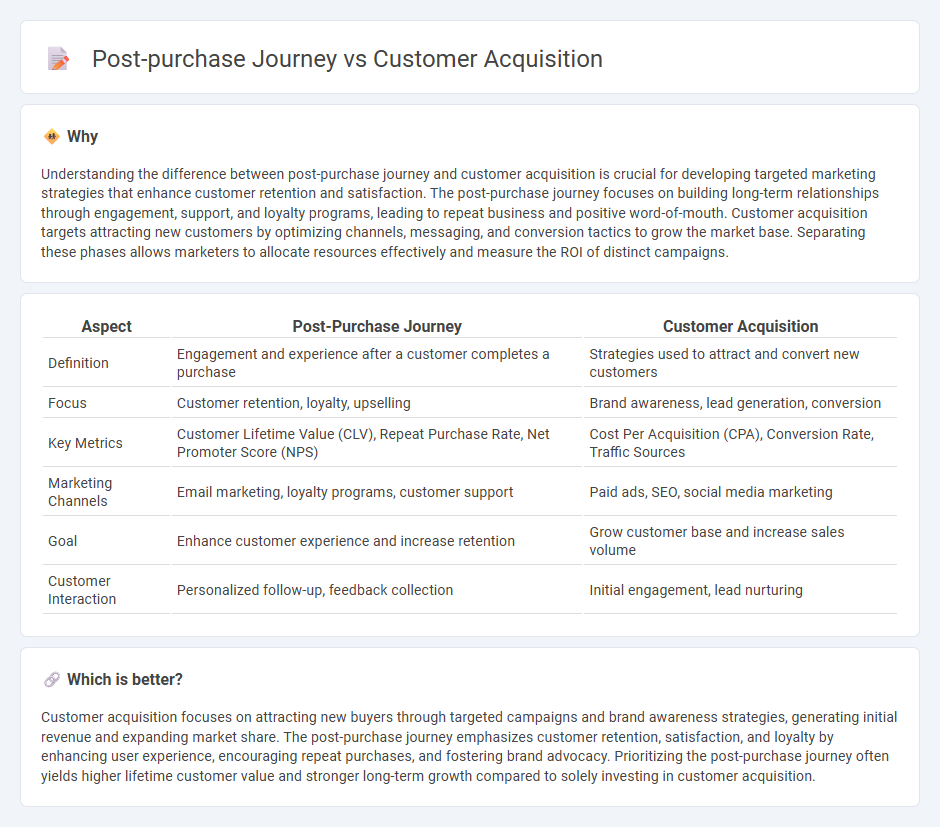
The post-purchase journey focuses on customer retention, satisfaction, and loyalty, driving repeat sales and lifetime value, while customer acquisition targets attracting new prospects through lead generation and conversion strategies. Effective marketing balances both by nurturing existing customers and expanding the customer base for sustained growth. Explore how optimizing each phase can amplify your overall marketing ROI.
Why it is important
Understanding the difference between post-purchase journey and customer acquisition is crucial for developing targeted marketing strategies that enhance customer retention and satisfaction. The post-purchase journey focuses on building long-term relationships through engagement, support, and loyalty programs, leading to repeat business and positive word-of-mouth. Customer acquisition targets attracting new customers by optimizing channels, messaging, and conversion tactics to grow the market base. Separating these phases allows marketers to allocate resources effectively and measure the ROI of distinct campaigns.
Comparison Table
| Aspect | Post-Purchase Journey | Customer Acquisition |
|---|---|---|
| Definition | Engagement and experience after a customer completes a purchase | Strategies used to attract and convert new customers |
| Focus | Customer retention, loyalty, upselling | Brand awareness, lead generation, conversion |
| Key Metrics | Customer Lifetime Value (CLV), Repeat Purchase Rate, Net Promoter Score (NPS) | Cost Per Acquisition (CPA), Conversion Rate, Traffic Sources |
| Marketing Channels | Email marketing, loyalty programs, customer support | Paid ads, SEO, social media marketing |
| Goal | Enhance customer experience and increase retention | Grow customer base and increase sales volume |
| Customer Interaction | Personalized follow-up, feedback collection | Initial engagement, lead nurturing |
Which is better?
Customer acquisition focuses on attracting new buyers through targeted campaigns and brand awareness strategies, generating initial revenue and expanding market share. The post-purchase journey emphasizes customer retention, satisfaction, and loyalty by enhancing user experience, encouraging repeat purchases, and fostering brand advocacy. Prioritizing the post-purchase journey often yields higher lifetime customer value and stronger long-term growth compared to solely investing in customer acquisition.
Connection
Post-purchase journey significantly impacts customer acquisition by fostering brand loyalty and turning buyers into advocates who generate referrals. Positive experiences during the post-purchase phase enhance customer lifetime value and reduce churn, creating a steady pipeline of new customers through word-of-mouth and social proof. Businesses leveraging data-driven insights from post-purchase interactions optimize marketing strategies to attract and convert prospects effectively.
Key Terms
Lead Generation
Effective lead generation strategies enhance the customer acquisition process by targeting potential buyers through personalized marketing campaigns and data-driven insights. Focusing on the post-purchase journey involves nurturing existing customers with tailored content and loyalty programs to drive repeat business and referrals. Explore proven tactics to optimize both stages and boost overall business growth.
Onboarding
Customer acquisition emphasizes attracting and converting potential buyers, while the post-purchase journey focuses on onboarding to ensure product adoption and customer satisfaction. Effective onboarding reduces churn, increases lifetime value, and accelerates time-to-value by guiding users through product features and support. Explore detailed strategies and metrics to optimize onboarding and enhance customer retention.
Customer Retention
Customer retention focuses on maximizing customer lifetime value by nurturing relationships through personalized communication, loyalty programs, and consistent product quality, distinguishing it from customer acquisition which aims to attract new buyers. Effective post-purchase journey management involves proactive support, feedback collection, and tailored offers to enhance satisfaction and reduce churn. Explore strategies to optimize retention and create lasting brand advocates for sustained business growth.
Source and External Links
What is Customer Acquisition? - IBM - Customer acquisition involves strategies to attract, nurture, and convert new customers into loyal advocates, focusing on measurable metrics like customer lifetime value and churn to ensure sustainable business growth and collaboration between marketing and sales teams.
What Is Customer Acquisition? The Complete Guide - Salesforce - Customer acquisition is the process of identifying and acquiring new customers through lead generation, nurturing, and conversion using channels such as online advertising, social media, SEO, and personalized communication to grow the paying customer base and revenue.
Customer acquisition strategies to grow your business - Adobe - Key customer acquisition strategies include SEO, content marketing, email marketing, and social media marketing, all aimed at attracting and converting potential customers through optimized digital content and direct engagement.
 dowidth.com
dowidth.com